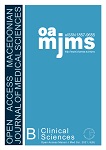Infants of Hypothyroid Mothers at Risk of Developing Hypothyroidism: A Cross-sectional Study in Qassim Region of Saudi Arabia
DOI:
https://doi.org/10.3889/oamjms.2021.7370Keywords:
Hypothyroidism, Mothers, Infants, Thyroid disease, PregnancyAbstract
Introduction
Hypothyroidism is one of the most prevalent endocrine disorders in women of childbearing age. If it goes untreated, can seriously affect maternal and fetal outcomes.
Aim
This study aimed to assess the prevalence of hypothyroidism in infants born to hypothyroid mothers and to analyze associated fetal complications.
Subjects and methods
This is a quantitative cross-sectional study conducted among pregnant mothers at Al Qassim region, Saudi Arabia. Data of pregnant women with clinical hypothyroidism during the last five years 2015-2019 were obtained from visiting records of Endocrine Clinic in Qassim University. These participants were contacted and written informed consents were obtained from the participants after a brief introduction of the study. A comprehensive survey questionnaire was used to collect information about demographic and study variables.
Results
153 mothers were enrolled. The most common age group was 31 – 45 years with mostly Saudis (93.5%). Complications during pregnancy were detected among 47.1% of mothers. The most common complication during pregnancy was C-section (26.8%). The prevalence of infants with hypothyroidism was 2.6% while the prevalence of newborn babies with temporary/permanent hypothyroidism was 4.6%. Decreased activity (7.8%) and an increased in weight (5.2%) were the most common symptoms of a child at the time of diagnosis.
Conclusion
Infants with hypothyroidism were not widely prevalent in this study. Cesarean delivery, gestational diabetes and anemia were some of the most common maternal complications during pregnancy.
Keywords
Downloads
Metrics
Plum Analytics Artifact Widget Block
References
Stricker R, Echenard M, Eberhart R, Chevailler M, Perez V, Quinn F, et al. Evaluation of maternal thyroid function during pregnancy: The importance of using gestational age-specific reference intervals. Eur J Endocrinol. 2007;157(4):509-14. http://doi.org/10.1530/EJE-07-0249 PMid:17893266 DOI: https://doi.org/10.1530/EJE-07-0249
Elahi S, Hussain Z. A longitudinal study of changes in thyroid related hormones among pregnant women residing in an iodine deficient urban area. ISRN Endocrinol. 2013;2013:234031. http://doi.org/10.1155/2013/234031 PMid:24236234 DOI: https://doi.org/10.1155/2013/234031
Cignini P, Cafà EV, Giorlandino C, Capriglione S, Spata A, Dugo N. Thyroid physiology and common diseases in pregnancy: Review of literature. J Prenat Med. 2012;6(4):64-71. PMid:23272277
Talat A, Khan AA, Nasreen S, Wass JA. Thyroid screening during early pregnancy and the need for trimester specific reference ranges: A cross-sectional study in Lahore, Pakistan. Cureus. 2019;11(9):e5661. http://doi.org/10.7759/cureus.5661 PMid:31720137 DOI: https://doi.org/10.7759/cureus.5661
Stagnaro-Green A, Abalovich M, Alexander E, Azizi F, Mestman J, Negro R, et al. Guidelines of the American thyroid association for the diagnosis and management of thyroid disease during pregnancy and postpartum. Thyroid. 2011;21(10):1081-125. http://doi.org/10.1089/thy.2011.0087 PMid:21787128 DOI: https://doi.org/10.1089/thy.2011.0087
Teng W, Shan Z, Patil-Sisodia K, Cooper DS. Hypothyroidism in pregnancy. Lancet Diabetes Endocrinol. 2013;1(3):228-37. http://doi.org/10.1016/S2213-8587(13)70109-8 PMid:24622371 DOI: https://doi.org/10.1016/S2213-8587(13)70109-8
De Groot L, Abalovich M, Alexander EK, Amino N, Barbour L, Cobin RH, et al. Management of thyroid dysfunction during pregnancy and postpartum: An endocrine society clinical practice guideline. J Clin Endocrinol Metab. 2012;97(8):2543 65. http://doi.org/10.1210/jc.2011-2803 PMid:22869843 DOI: https://doi.org/10.1210/jc.2011-2803
Aboelroose AA. Assessment of thyroid function in pregnant women attending Suez Canal University Hospitals. Int J Pregnancy Child Birth. 2019;5(5):65-9. DOI: https://doi.org/10.15406/ipcb.2019.05.00181
Vinodhini S. An Analytical Cross Sectional study on Hypothyroidism in Pregnancy, Its Maternal and Fetal Outcome: Kilpauk Medical College, Chennai; 2019.
Gupta M, Pandotra P, Jindal M, Jamwal G, Goraya S, Gupta V. Comparative study of feto-maternal outcome in clinical and subclinical hypothyroidism. Int J Reprod Contracept Obstet Gynecol. 2017;6(5):1910. DOI: https://doi.org/10.18203/2320-1770.ijrcog20171947
Männistö T, Mendola P, Grewal J, Xie Y, Chen Z, Laughon SK. Thyroid diseases and adverse pregnancy outcomes in a contemporary US cohort. J Clin Endocrinol Metab. 2013;98(7):2725-33. http://doi.org/10.1210/jc.2012-4233 PMid:23744409 DOI: https://doi.org/10.1210/jc.2012-4233
Fallatah AM, Hasanain A, Babatin H, Nassibi KM, Thigah S, Abduljabbar HS. Pregnancy outcomes among obese pregnant women with hypothyroidism: Medical record review of a single tertiary center in Saudi Arabia. Cureus. 2020;12(2):e6938. http://doi.org/10.7759/cureus.6938 PMid:32190490 DOI: https://doi.org/10.7759/cureus.6938
Al Shanqeeti SA, Alkhudairy YN, Alabdulwahed AA, Ahmed AE, Al-Adham MS, Mahmood NM. Prevalence of subclinical hypothyroidism in pregnancy in Saudi Arabia. Saudi Med J. 2018;39(3):254. http://doi.org/10.15537/smj.2018.3.21621 PMid:29543303 DOI: https://doi.org/10.15537/smj.2018.3.21621
Hussein KS. Prevalence of thyroid dysfunction among Saudi women in early pregnancy at King Abdulaziz University Hospital. World J Environ Biosci. 2017;6:21-5.
Rovelli R, Vigone MC, Giovanettoni C, Passoni A, Maina L, Corrias A, et al. Newborn of mothers affected by autoimmune thyroiditis: The importance of thyroid function monitoring in the first months of life. Ital J Pediatr. 2010;36(1):24. http://doi.org/10.1186/1824-7288-36-24 PMid:20219125 DOI: https://doi.org/10.1186/1824-7288-36-24
Taha I, Alhazmi J, editors. Prevalence of Overt and Subclinical Hypothyroidism among Saudi Pregnant Women Attending Two Referral Hospitals in Saudi Arabia and Associated Maternal and Fetal Complications. Society for Endocrinology BES; 2011.
Zhou J, Luo J, Lin J, Zeng Y, Qiu X, Zhu W, et al. Perinatal risk factors for congenital hypothyroidism: A retrospective cohort study performed at a tertiary hospital in China. Medicine. 2020;99(26):e20838. http://doi.org/10.1097/MD.0000000000020838 PMid:32590776 DOI: https://doi.org/10.1097/MD.0000000000020838
Panicker V. Genetics of thyroid function and disease. Clin Biochem Rev. 2011;32(4):165-75. PMid:22147956
Andersen SL, Andersen S. Turning to thyroid disease in pregnant women. Eur Thyroid J. 2020;9:225-33. DOI: https://doi.org/10.1159/000506228
Grattan MJ, Thomas DS, Hornberger LK, Hamilton RM, Midodzi WK, Vohra S. Maternal hypothyroidism may be associated with CHD in offspring. Cardiol Young. 2015;25(7):1247-53. http://doi.org/10.1017/S1047951114001887 PMid:25275697 DOI: https://doi.org/10.1017/S1047951114001887
Tudosa R, Vartej P, Horhoianu I, Ghica C, Mateescu S, Dumitrache I. Maternal and fetal complications of the hypothyroidism-related pregnancy. Maedica. 2010;5(2):116. PMid:21977134
Tan TO, Cheng YW, Caughey AB. Are women who are treated for hypothyroidism at risk for pregnancy complications? Am J Obstet Gynecol. 2006;194(5):e1-3. DOI: https://doi.org/10.1016/j.ajog.2005.11.028
Downloads
Published
How to Cite
Issue
Section
Categories
License
Copyright (c) 2020 Mariam S. Alharbi (Author)

This work is licensed under a Creative Commons Attribution-NonCommercial 4.0 International License.
http://creativecommons.org/licenses/by-nc/4.0








